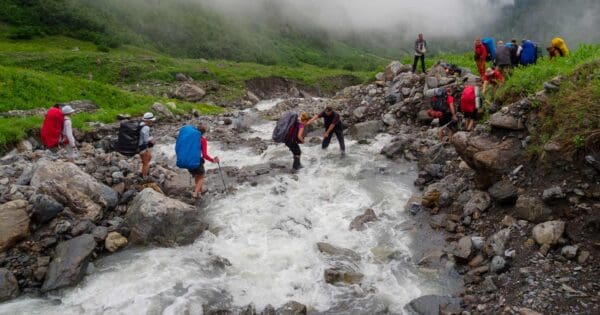Hiking is a popular outdoor activity that allows people to immerse themselves in nature and enjoy the beauty of the wilderness. Trails are established to guide hikers and ensure they stay on designated paths, minimising their impact on the environment. However, a phenomenon known as trail braiding can occur, which has implications for the health of the trails and the ecosystems they traverse.
What is trail braiding?

Trail braiding refers to the creation of multiple, informal trails that deviate from the main designated trail, resulting in a network of unofficial paths that intersect and overlap with the original trail. This can happen when hikers veer off the established path to take shortcuts, explore off-trail areas, or bypass obstacles such as mud or fallen trees. Over time, repeated use of these unofficial paths can cause them to widen and erode, leading to environmental degradation.
Why does trail braiding matter?
Trail braiding has several negative impacts on the environment, hikers, and wildlife. Some of the key reasons why it matters include:
- Environmental damage: Trail braiding can lead to soil erosion, loss of vegetation, and disruption of wildlife habitats. The multiple, unofficial trails can cause increased sedimentation in nearby streams and rivers, damage delicate plant species, and disturb wildlife populations.
- Loss of trail integrity: Trail braiding can result in a complex network of intersecting paths that can be confusing for hikers, leading to loss of trail integrity. It can be frustrating and unsafe for hikers to navigate a maze of unofficial trails, which can also cause damage to sensitive areas by trampling on vegetation and disturbing wildlife.
- Fragmentation of wilderness: The proliferation of unofficial trails can fragment the wilderness, disrupting the natural flow of ecosystems and creating barriers for wildlife movement. This can have negative consequences on wildlife populations, including habitat fragmentation and reduced genetic diversity.
- Difficulty in trail maintenance: Managing and maintaining multiple, unofficial trails can be challenging for land managers and trail volunteers. It can require additional resources, time, and effort to restore and maintain the original designated trail, and it may not always be feasible to restore all the braided trails.
What if the trail is muddy?

If the designated trail is muddy, it can be tempting to create unofficial paths or bypass the mud by veering off the trail. However, it’s important to resist the urge to do so, as trail braiding can have negative impacts on the environment and the hiking experience. Here are some steps you can take if you encounter muddy trails:
- Stay on the designated trail: Stick to the established trail, even if it’s muddy. Avoid creating new paths or shortcuts, as this can contribute to trail braiding and cause further erosion and damage to vegetation. Always walk on boardwalks if they exist.
- Use proper hiking techniques: If you encounter muddy sections on the trail, use proper hiking techniques to minimise your impact. Walk through the center of the trail, avoiding the edges where vegetation may be more sensitive to trampling. Try to step on rocks or logs, if available, to avoid sinking into the mud.
- Be prepared: Expect and plan for muddy trails by wearing appropriate footwear, such as waterproof or quick-drying hiking boots, and carrying hiking poles for stability. Bring extra clothing to change into if you get wet, and pack a trash bag to pack out any muddy gear to leave no trace. Wearing gaiters can also help keep the mud of your hiking clothes and boots.
- Follow posted signs and guidelines: Respect any posted signs or guidelines regarding muddy trails or trail closures. These signs are usually put in place by land management agencies or trail organisations to protect the trails and surrounding ecosystem, and it’s important to follow their instructions.
- Report trail conditions: If you encounter excessively muddy trails or hazardous conditions, report it to the appropriate authorities or trail organisations. They may be able to take steps to address the issue, such as placing additional signage, improving drainage, or rerouting the trail. In particularly wet locations, land managers will even build boardwalks to prevent trail braiding from occurring.
Remember, hiking in muddy conditions may be challenging, but it’s part of the natural process of being in the outdoors. By staying on designated trails, using proper hiking techniques, and respecting posted guidelines, you can help protect the environment and maintain the integrity of the trails for yourself and others to enjoy.
How to prevent trail braiding

As responsible hikers, it’s important to take steps to prevent trail braiding and minimise our impact on the environment. Here are some tips to help prevent trail braiding:
- Stay on designated trails: Stick to the established trails and avoid creating new paths, even if it seems like a shortcut or an interesting off-trail exploration. Follow posted signs and respect trail closures, and do not create new paths to bypass obstacles. Always walk on boardwalks if they exist.
- Educate others: Educate fellow hikers, especially those who may be new to hiking, about the importance of staying on designated trails and avoiding trail braiding. Share information about Leave No Trace principles and responsible outdoor ethics.
- Follow Leave No Trace principles: Follow the Leave No Trace principles, which include guidelines such as “stick to established trails” and “leave what you find.” These principles promote responsible outdoor recreation and minimise human impact on natural environments.
- Report trail braiding: If you come across instances of trail braiding during your hike, report it to the appropriate land management agency or trail organization. They can take steps to assess and address the issue, such as restoring the original trail and installing signage or barriers to prevent further braiding.
Conclusion

Trail braiding is a phenomenon that can have negative impacts on the environment, hikers, and wildlife. By understanding what it is and why it matters, we can take steps to prevent trail braiding and protect our wilderness areas for future generations to enjoy. As responsible hikers, it’s our responsibility to stay on designated trails, follow Leave No Trace principles, educate others, and report instances of trail braiding. By working together, we can minimise our impact on the environment and ensure that our hiking trails remain healthy, intact, and enjoyable for years to come. Let’s do our part to protect our trails and preserve the beauty of nature for ourselves and future generations of outdoor enthusiasts.






It’s so easy to look at a muddy trail and think ‘ahh, I don’t want to get all muddy, I’ll just walk around’. But as a nature lover, I believe we always have to put nature first. I’ve seen many tails become 3+ metres wide because we’ve tried to avoid them.
Its very noticeable on the Razorback….
…but the only way to do the Northern Prom..🤣
Nick Wright yeah well there’s a good point. Can’t avoid that swamp